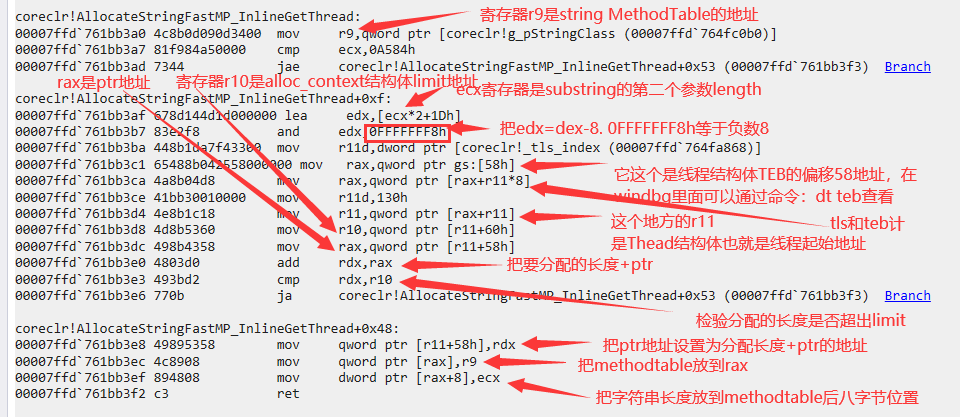Substring 在BCL和CLR裡面搞了啥
楔子
還是做點事情,不要那麼散漫。
本文以簡單的Substring(int startindex,int Length)函數為例,來遞進下它在託管和非託管的一些行為。
以下均為個人理解,如有疏漏請指正。
定義和實現
它的定義是在System.Runtime.dll裡面
public string Substring(int startIndex, int length)
{
throw null;
}
它的實現在System.Private.CoreLib.dll裡面
public string Substring(int startIndex, int length)
{
//此處省略一萬字
return InternalSubString(startIndex, length);
}
繼續來看下InternalSubString
private string InternalSubString(int startIndex, int length)
{
string text = string.FastAllocateString(length);
UIntPtr elementCount = (UIntPtr)text.Length;
Buffer.Memmove<char>(ref text._firstChar, Unsafe.Add<char>(ref this._firstChar, (IntPtr)((UIntPtr)startIndex)), elementCount);
return text;
}
FastAllocateString是個FCall函數(也就是微軟提供的在託管裡面呼叫非託管的一種方式,它的實際實現是在JIT裡面)
[MethodImpl(MethodImplOptions.InternalCall)]
internal static extern string FastAllocateString(int length);
Buffer.Memmove是個託管函數,它的作用主要是把FastAllocateString返回的string物件賦值為startIndex和elementCount中間的字串。過程是利用了Unsafe.Add(它的定義在System.Runtime.CompilerServices,實現實在CLR裡面)指標偏移來實現,過程比較簡單,不贅述。
FastAllocateString
重點在於這個函數,這個函數進入到了非託管。它進入的方式是通過RyuJit載入這個方法的IL程式碼。然後對這個IL程式碼進行解析,重構成組合程式碼。
它的非託管原型如下:
#define _DYNAMICALLY_ASSIGNED_FCALLS_BASE() \
DYNAMICALLY_ASSIGNED_FCALL_IMPL(FastAllocateString, FramedAllocateString) \
FramedAllocateString原型如下:
HCIMPL1(StringObject*, FramedAllocateString, DWORD stringLength)
{
FCALL_CONTRACT;
STRINGREF result = NULL;
HELPER_METHOD_FRAME_BEGIN_RET_0(); // Set up a frame
result = AllocateString(stringLength);
HELPER_METHOD_FRAME_END();
return((StringObject*) OBJECTREFToObject(result));
}
HCIMPLEND
注意了,FastAllocateString實際上呼叫的不是FramedAllocateString。因為在CLR啟動載入的時候,FastAllocateString被替換成了FCall函數形式的呼叫
ECall::DynamicallyAssignFCallImpl(GetEEFuncEntryPoint(AllocateStringFastMP_InlineGetThread), ECall::FastAllocateString);
DynamicallyAssignFCallImpl原型:
void ECall::DynamicallyAssignFCallImpl(PCODE impl, DWORD index)
{
CONTRACTL
{
NOTHROW;
GC_NOTRIGGER;
MODE_ANY;
}
CONTRACTL_END;
_ASSERTE(index < NUM_DYNAMICALLY_ASSIGNED_FCALL_IMPLEMENTATIONS);
g_FCDynamicallyAssignedImplementations[index] = impl;
}
可以看到FastAllocateString作為了索引Index,而他的實現是AllocateStringFastMP_InlineGetThread。
再來看下它的堆疊
> coreclr.dll!ECall::DynamicallyAssignFCallImpl(unsigned __int64 0x00007ffdeed5df50, unsigned long 0x061b1d50) C++
coreclr.dll!InitJITHelpers1() C++
coreclr.dll!EEStartupHelper() C++
coreclr.dll!`EEStartup'::`9'::__Body::Run(void * 0x0000000000000000) C++
coreclr.dll!EEStartup() C++
coreclr.dll!EnsureEEStarted() C++
coreclr.dll!CorHost2::Start() C++
coreclr.dll!coreclr_initialize(const char *
很明顯它是在CLR初始化的時候被替代的
何時被呼叫
最後一個問題,既然FastAllocateString被替代了,那它何時被呼叫的呢?
在程式碼:
private string InternalSubString(int startIndex, int length)
{
string text = string.FastAllocateString(length);
UIntPtr elementCount = (UIntPtr)text.Length;
Buffer.Memmove<char>(ref text._firstChar, Unsafe.Add<char>(ref this._firstChar, (IntPtr)((UIntPtr)startIndex)), elementCount);
return text;
}
這裡面呼叫了string.FastAllocateString函數,通過上面推斷,實際上它已經被被替換了。注意了,但是替換之前,還得按照CLR記憶體模型進行運作呼叫。當我們呼叫InternalSubString的時候,裡面呼叫了FastAllocateString,後者通過PrecodeFixupThunk來進行替換。
這點可以通過組合驗證:
System_Private_CoreLib!System.String.InternalSubString+0xc:
00007ffd`9a86132c 418bc8 mov ecx,r8d
0:000> t
System_Private_CoreLib!System.String.InternalSubString+0xf:
00007ffd`9a86132f ff15b39f7e00 call qword ptr [System_Private_CoreLib+0x9cb2e8 (00007ffd`9b04b2e8)] ds:00007ffd`9b04b2e8={coreclr!AllocateStringFastMP_InlineGetThread (00007ffd`9b20b3a0)}
0:000> t
coreclr!AllocateStringFastMP_InlineGetThread:
00007ffd`9b20b3a0 4c8b0d090d3400 mov r9,qword ptr [coreclr!g_pStringClass (00007ffd`9b54c0b0)] ds:00007ffd`9b54c0b0=00007ffd3b6ed698
call qword ptr [System_Private_CoreLib+0x9cb2e8 (00007ffd`9b04b2e8)] ds:00007ffd`9b04b2e8={coreclr!AllocateStringFastMP_InlineGetThread (00007ffd`9b20b3a0)}
就是直接呼叫了AllocateStringFastMP_InlineGetThread,然後跳轉到後者的地址
AllocateStringFastMP_InlineGetThread
這個函數的作用實際上是申請記憶體,比如你 new 一個物件的時候,又或者本例,你需要一個新的字串物件來儲存擷取的字串。

作者:江湖評談
版權:本作品採用「署名-非商業性使用-相同方式共用 4.0 國際」許可協定進行許可。
